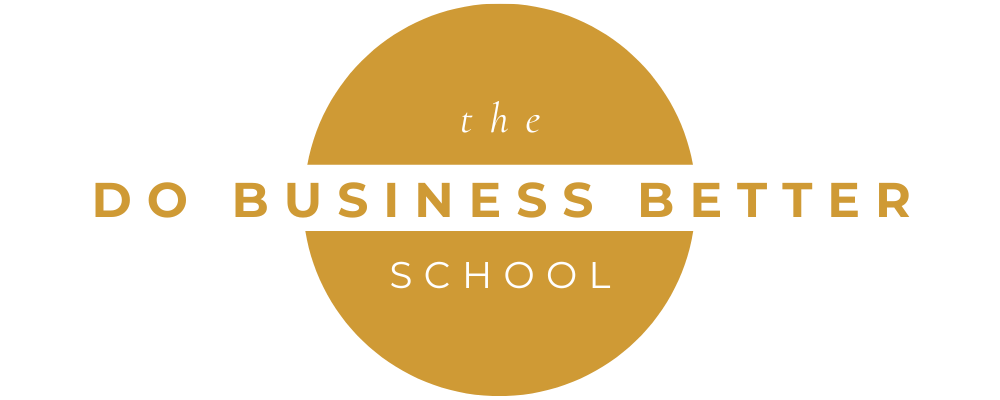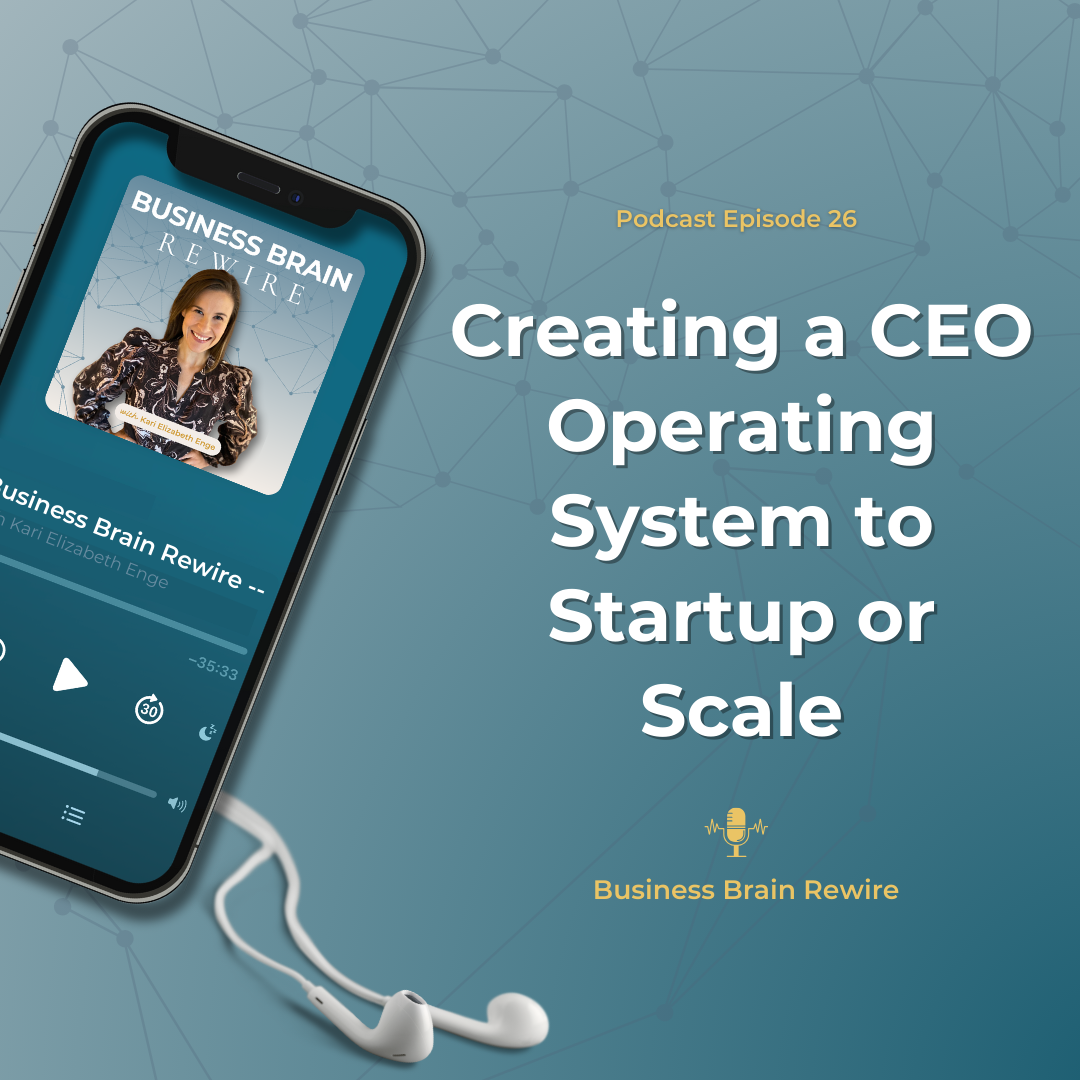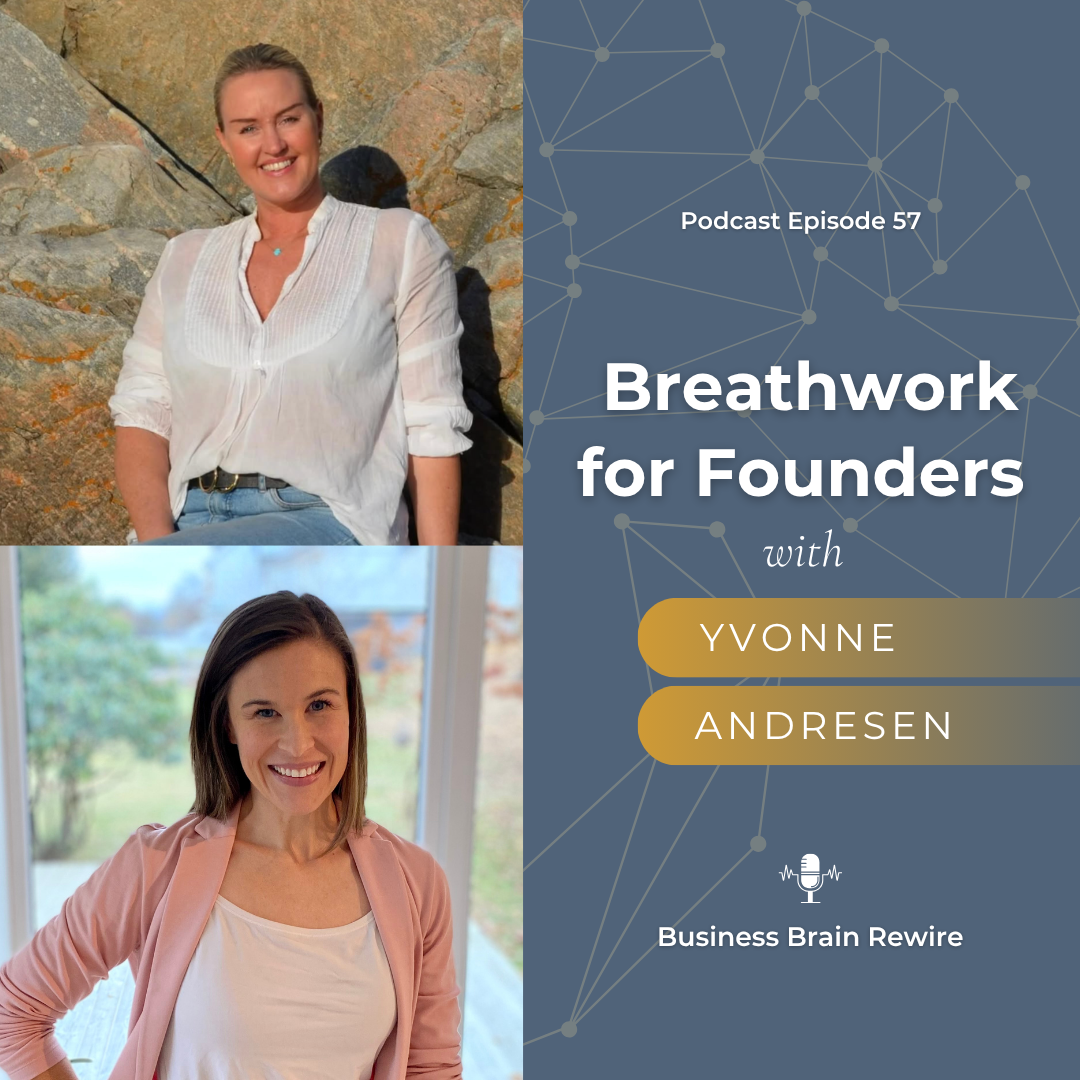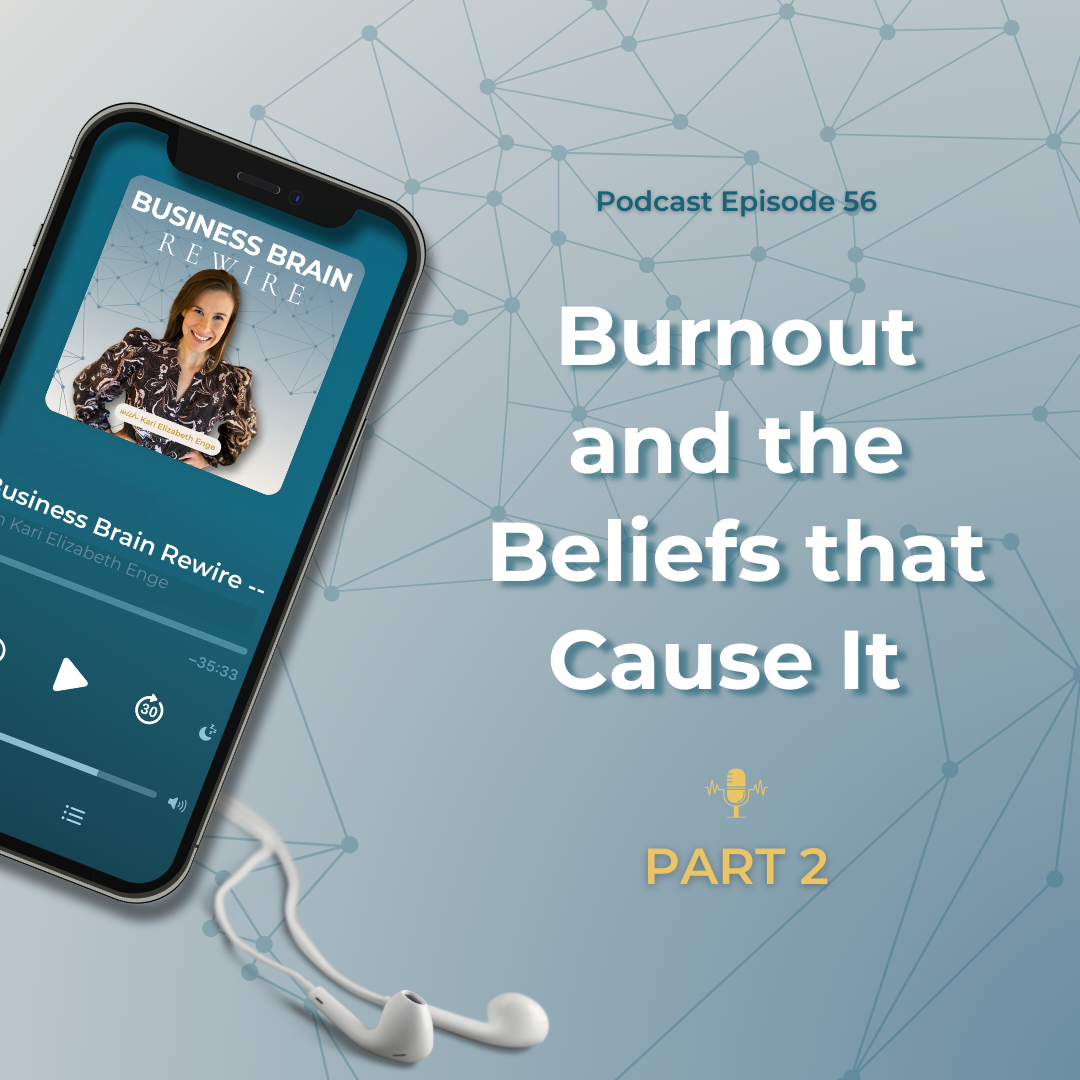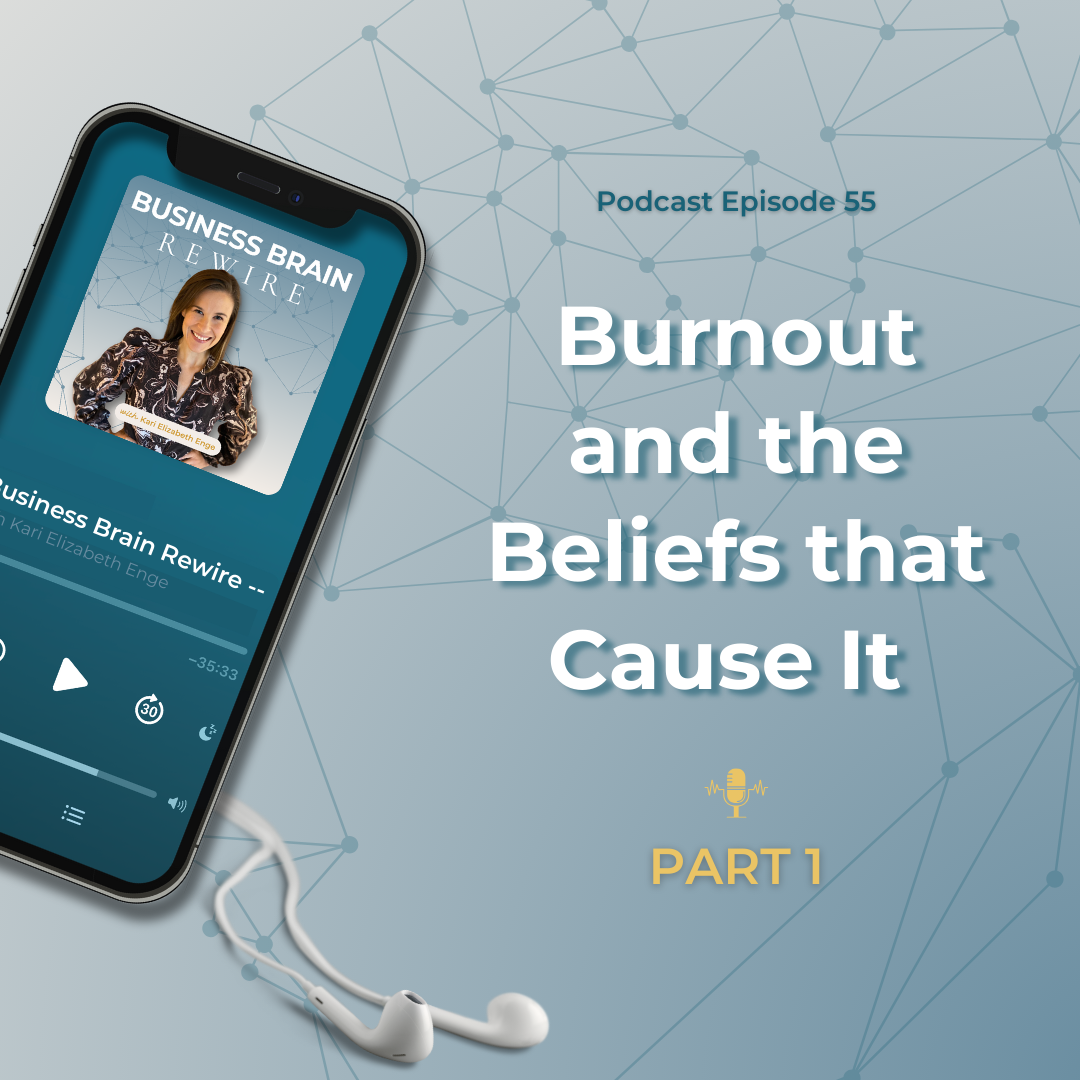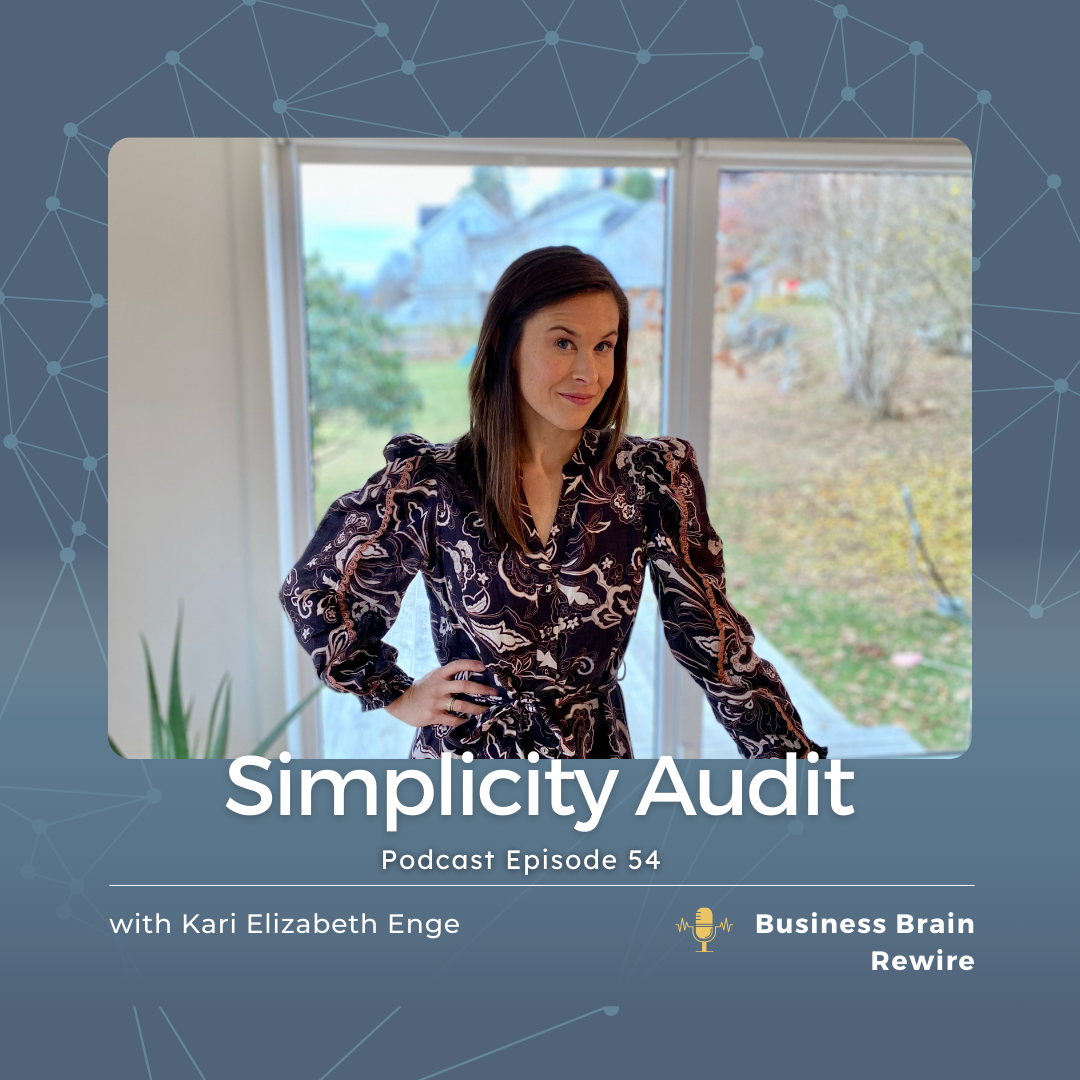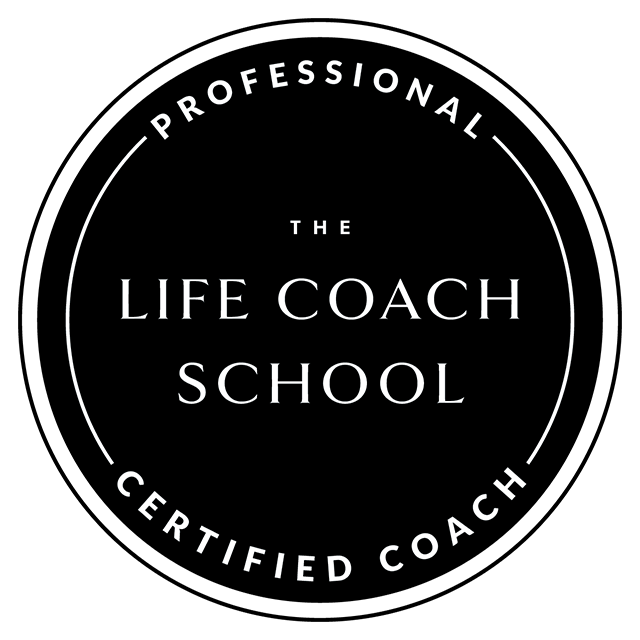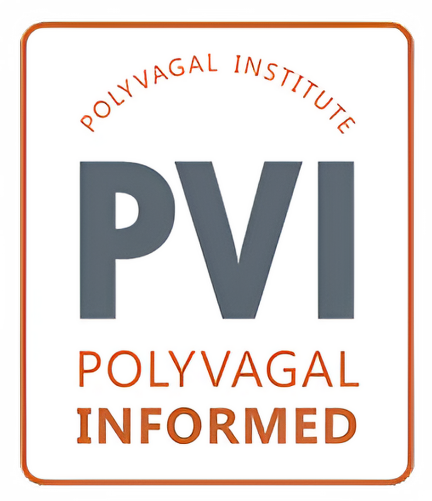Early on as a founder, I was like splattered paint on the wall. And I didn’t even know it.
I spent the first decade of my career climbing the corporate ladder in an intense corporate environment, traveling the globe.
Quite frankly, I thought I was really smart back then.
I didn’t have a large team to delegate to in the beginning and I needed to uplevel my approach.
Over the last almost decade of entrepreneurship, I’ve created 4 CEO Rules I live by. I view these fundamentals as my operating principles or system. And it’s greeted loads of balanced, sustainable success for me.
Tune in to today’s episode to learn these 4 principles so you can put them into practice and see your company grow in a sustainable way too.
Every Monday, I share a neuroscience-based strategy to grow your company that you won’t find anywhere else. Subscribe to get access to the systems you need for sustainable success.
[00:00:00] Welcome to today’s show. I have been talking to several founders recently about showing up as a more strategic CEO. Not necessarily- what they’re doing in their company, not the strategies, but how the CEO is actually thinking about and approaching the business, using their own CEO brain.
[00:01:11] This is something that a lot of founders don’t think about, especially when they first start their business. They’re very focused on the right business idea, the right business model, gaining traction, the marketing strategy that’s going to work and they run around trying to just take as much action as possible, as quickly as possible, to get the needle moving.
[00:01:36] As the founder, you know, gets a workable system going. They often realize, wow, I was kind of like splattered paint on the wall, back then. I was kind of like running around like a chicken with my head cut off. And I need to form a more strategic structured, sustainable way of approaching my business, otherwise this is not going to be sustainable and I’m not going to be able to scale this. Sometimes this aha moment for founders doesn’t actually happen until there is a major conflict. There might be a conflict with a co-founder or a team member. There might be unhappy employees. There might be really big mistakes happening, things falling through the cracks that they now see as a major issue and one that comes from this kind of spotters paint on the wall mentality.
[00:02:31] So today, I want to talk to you about how to overcome this as a founder. It can happen in the startup phase, but it can also happen at other phases as well. Oftentimes it’ll happen with scale ups when they’re trying to reach that next level and they just can’t break through. It often comes back to how the CEO is actually thinking about approaching, leading and structuring the company.
[00:02:59] I also have witnessed, founders and CEOs in my own family, we have several entrepreneurs in my family and several family members who work on startup teams. It’s just been so fascinating to watch the drama play out and the struggle play out when the company is trying to grow and when that CEO, especially that founder role, is actually the roadblock without knowing it.
[00:03:28] So we’re going to talk today about how to create eat a CEO operating system. A set of rules and principles and philosophies and practices that you follow as a founder in order to start up and scale in a more structured, sustainable, and strategic way.
[00:03:51] Great. First question for you to ask is: Do I have an operating system? Or another way of asking this is: Do I even focus on me as a CEO? Do I ever think about how I’m approaching my business, how I’m thinking about my business, how I structure my planning, my implementation, my evaluation. I really want you to consider if you even have CEO skillsets on your radar. A lot of startup founders don’t and I know that this was the case for me in the early days. I spent the first decade of my career out of college really hustling, but I didn’t really know I was hustling. I thought like, oh no, I’m, I’m good. I’m just enjoying, traveling and working and experiencing the world. And it wasn’t until I experienced a burnout and the desire to shift out of that corporate mentality in that corporate environment and to do something more purpose driven and when I had motherhood on the horizon that I was like, you know what? I think I’m hustling.
[00:05:09] So I quit my corporate ladder climbing, you know, jet setting, busy lifestyle to start a purpose driven, balanced a business that I could really integrate my personal life and my wellbeing into. And also just to create more impact in the world in a way that really aligned with my values. But guess what? How you get there is how you stay there.
[00:05:33] So I really accidentally brought my hustle mentality to my business where I was focused on action taking above all else. Now again, I didn’t know this. I thought I was just being strategic and coming up with good ideas and implementing them and moving the needle. But I now know. Looking back that my number one focus was action taking and speed. And whenever action taking in speed is your main priority, you know that you are in the hustle mentality.
[00:06:11] So that’s the first thing I want you to really think about is what is my focus and how am I approaching my business? Do you have a really intentional, simplified, structured way of approaching your business? Or are you just running to get things working and constantly thinking about what you should do and what’s the right way to do it and trying to speed things up.
[00:06:38] After you’ve gotten a lay of the land of what your current CEO approach is. We want to up-level that. I talked to a lot of founders, mainly who I’ve just met and we kind of start talking about what I do and what I teach, and I mentioned to them that I teach neuroscience based business growth strategies and tools. And I talked to them about how I help grow businesses faster, but also to cut a founder stress in half while doing so, and a lot of founders when they first hear me say the word stress, their immediate response to me is: uh, oh, like I’m really good at handling stress. I run three companies and I’m a mom and I know like, I I’ve like I’ve got it.
[00:07:27] Which always makes me smile because normally when a founder is bragging about how much they have on their plate, they’re actually swimming in the water of stress. But they’re kind of like efficient fishbowl, right? A fish doesn’t know it’s swimming in water because that’s all it knows. And so a lot of times founders will get in that busy hustle and they’ll think that this is just them operating really strategically when there actually is a second, third and fourth option on the table that has increased levels of success tied to it and lower stress.
[00:08:07] There is always an opportunity, no matter how long you’ve been in business or how smart you think you are or how well your business is operating, there is always a way you can uplevel your approach as a CEO. There’s always a founder weakness in you, and there is always another tool or another skill set to be strengthened. What I would love for you to do as we continue this conversation today is to reflect on what that weakness might be for you. What might be that roadblock that you personally are bringing to the business? Even if you don’t know it.
[00:08:46] I like to do this a lot in my marriage. Right? Like I have a great marriage. I really love my husband. We are really great partners. We’ve been through ups and downs and we’re learning over time how to problem solve and find more joy and fulfillment, and it’s an ever going journey. So I don’t like to ever settle in my marriage where I’m like, you know what, like we’ve got this. We’ve got this marriage thing because the moment that happens is the moment that we start to disconnect on accident. Right. And that’s happened before where we get into kind of a routine or a rut, and then we have to reconnect and say okay, let’s come back together and regroup.
[00:09:33] Your business is the same way. It is an ever growing, evolving project, right? One of the most important projects of your life that you need to continually be approaching in a more high level way with higher level thinking, feeling and doing, with constant personal growth and development so that you can lead the ship better and better and better.
[00:10:01] That’s what I want you to think about. How can you actually pick something to focus on, to increase your CEO skillsets over time. Now, once you do this, you will start to form what I call a CEO operating system. This CEO operating system is basically like a list of principles and values and a way that you approach your business as the CEO.
[00:10:34] What I’m going to do is I’m going to share just some of my CEO operating principles with you. These are kind of like the rules that I do business by. I’m going to talk a little bit about them so that you can get inspired about forming your own set of operating system principles to do your business by. These are not the same as values, although you can think of them like that, if you prefer. So as I start sharing mine, you can interchange, you know, the word operating principles with values, rules, philosophies, whatever term really resonates with you. The important thing is, is that these are not just lovely sounding things that you put on the wall as a value, like vulnerability, authenticity, right? These are not those types of old school corporate values. These are actually things that you live by. You use as a filter for all your decisions, all your action taking and every single day that you show up to your business, you’re using this operating system.
[00:11:46] So here are probably my top four principles in my CEO operating system. Number one is nervous system regulation. This might sound like a really strange thing to have all the top of the list, but if you’ve been listening to business brain rewire for a while, you understand why your nervous system, scientifically, is so important for your founder brain.
[00:12:14] Your entire brain and your body as well, completely changes and shifts with a different cocktail of hormones and different things firing in the brain, depending on which nervous system state you are in. When you are feeling safe and grounded, you will automatically have better cognitive function. You will have full access to the prefrontal cortex, which is the part of the brain that you need to be using for your business. You will be more easily, a naturally, socially, engaging, which means that your sales and marketing is going to land better. You will be able to problem solve more efficiently and effectively, meaning that the ideas that will come to your brain will be more high quality. You will be able to connect the dots in a much simpler way, which means your strategies will be streamlined and really potent and powerful, not cluttered. You’ll be able to make decisions faster and keep those decisions simple. This is number one on my list because some of the other parts of my operating system are about simplicity and about sales and marketing. And unless my nervous system is regulated, I don’t get the biggest bang for my buck on the other ones.
[00:13:37] Your nervous system really comes first. Again, because it changes your biology. It changes your brain, and your business is your brain, right? So if you don’t have a very good functioning brain, you’re not going to grow your business. It’s really important that you learn about your nervous system. You learn about the different states and what those states look like, and you learn simple tools and exercises to shift your nervous system.
[00:14:07] In simply sustainable program, I teach our founders how to do and nervous system check-in and a three minute reset. I provide a whole library of simple three minute exercises to use. Now, the secret sauce to this in my operating system is that we don’t just do this, like in the morning and at night, which is normally how people view this, right? They will exercise in the morning. They will have a stillness practice, a meditation practice, a moment where they wind down after work and kind of recover. They check that off as their nervous system regulation.
[00:14:45] But, with the simply sustain a sustainable system, what I have found so powerful, is integrating these nervous system resets within your work day. I literally do three minute little resets, all the time throughout my work day, and this can look really simple if you know exactly how to identify which state you’re in and which exercise goes with that state, you can do it three minutes, you’re shifted and you’re back to being really sharp and focused and energized, but in a way that feels fun, right? That doesn’t feel draining or tiring.
[00:15:22] I love the quote by Mike Vance that says slowing down is often the best way to speed up. It’s true when you slow things down for your nervous system, your biology shifts and it makes you automatically speed up, just because your brain problem solves for you more effectively. How fun is that? So that’s number one.
[00:15:46] Number two is simplify. You’re going to hear this word from me a lot. Right? It’s in the name of my goal achievement system, simply sustainable.
[00:15:57] If you have ever been in an accelerator program, you will have heard of the minimal viable product right? It’s kind of like an household concept in entrepreneurial lightened, right? And yet, so many founders have trouble simplifying. So really it’s the mentor’s job in a lot of accelerators to just keep helping them trim the fat trim, the fat trim, from the fat, off off the business idea off of the value proposition for that new company.
[00:16:32] But I like to think about simplicity, not as something that you do in the beginning when you’re just starting. But literally an operating principle that my business is structured around. I blend a simplicity into every single decision I make. I like things to be as simple as possible. Whenever I am thinking about my business model, my marketing strategy, my messaging, and any implementation plan or decision I make.
[00:17:08] A million dollar question that is going to help you so much, is a regularly asking how can I simplify this? How can I make the minimal viable decision here? How can I make the minimal viable strategy here? How can I make the minimal viable implementation plan here? Now, this is not done to reduce quality. I think that that’s one of the things that I see a lot with new founders, especially in my accelerator program last year, I had to keep on explaining to new founders that the MVP concept is not about reducing quality. It’s about simplifying so that you open up bandwidth to give quality to only the needle movers. Okay. Let me say that again.
[00:17:59] The MVP process is not about chunking down and simplifying and reducing features so that it has less quality. I think that that’s a lot of times what founders think in the beginning. They think, okay, we don’t have a lot of money and we don’t have a lot of resources so we have to go with this, like less than ideal version of our product.
[00:18:22] The real reason why we simplify it and why we use an MVP philosophy, just all around, just as an operating principle for a company is because it helps you to open up your bandwidth for only the needle movers, because you’re going to have a less things to focus on. And so, it can help you to really focus on quality for those few things. It is actually about increasing the quality while using limited bandwidth, not reducing the quality because you don’t have enough money or a time, you get me?
[00:19:04] What I want you to really think about, let’s put aside how far you think your business is right now, whether you think like I’ve got this under my belt. I know the lean startup. I don’t need to use that anymore. I’m past that. I really want you to check in with yourself to ask. Are you following a minimal viable product philosophy? Do you value simplicity and use it as a filter for decision-making in your business? If the answer’s no. Then we want to integrate that. Most of the time, the answer will be, well, sometimes I do, I do it here, but I don’t do it there. A great exercise is to go on a hunt for maybe the places in your business where you are not simplifying and trimming the fat, like in chunking down as much as you can so that you can really increase the quality, around the few things that you are using to move the needle.
[00:20:04] The other thing that I really like to touch on when I teach simplicity is simplicity in the context of messaging and marketing. Simplicity cuts through noise and the only reason why customers don’t buy from a company is because they don’t want what you’re selling or they don’t trust you. Those are literally the only two reasons. In both cases, it’s really just because you didn’t communicate the value proposition clear enough and well enough.
[00:20:36] We can use simplicity to really troubleshoot that problem when this is a roadblock for a company. We can use simplicity to really create crisp, hard hitting, easy, simple messaging that cuts through and creates a lot of clarity. Oftentimes entrepreneurs think: I need, I need more compelling messaging, but really what they need is clear messaging, more simple messaging.
[00:21:03] Then once we get that messaging really crisp and cleaned up and tight. We want to create a simpler, more potent marketing plan that’s not full of stuff, but that’s really lasered in on just one or two things that we can ramp up quality and also emotional connection. Which leads me to my third operating system principal on my list.
[00:21:32] True connection is so underrated and it’s not taught. I think a lot of people and business coaches and business leaders, they try to teach emotional connection, but they do it oftentimes with too much of a feminine, spiritual, woo woo manifesty style. It leaves a lot of people feeling like, oh, that’s not for me. That was the case in my own entrepreneurial journey. When I first started my business, I felt like, you know what, you either have to read these really like masculine testosterone driven, hustley, tips and tricks and hacks type of business advice, or you have on the other end of the spectrum, like this spiritual, just manifest your dreams kind of style.
[00:22:23] I just thought that both didn’t resonate with me. That’s why I actually started rank and file magazine in the early days, because I wanted a business advice publication that was not this woo spiritual thing or this get rich, get fast, tips and tricks and hacks. Right? I wanted a business environment where we could talk about really making the world a better place using business, doing it in a sustainable balanced way that is healthy for the founder’s brain and body and sustainable for their family, sustainable for their community and using relate scientific, conscious intentional ways of leading that company in a way that really reflected everything else that I was doing in my parenting and in my relationships. So that’s what started me on this business journey in the first place.
[00:23:23] Emotional connection is one of those things that’s often misunderstood and that I’m really on a mission to teach in a more scientific, approachable way for all founders, especially the purpose driven, conscious, sustainably minded ones of us. What is emotional connection? I actually talked about this in a couple of episodes ago. I believe in episode 23 or four, so I will link to it in the show notes. Emotional connection is about feeling safe and secure in sufficient in your own self, in your own body. Filling up your cup so that you can then shift your focus to your customer or to another human being so that you can put yourself in their mental and emotional shoes, really resonate and connect with them, so that you can break through and have a moment where you are actually speaking to one another, getting each other’s attention and collaborating. It’s a really important for sales and marketing. It’s important for your team. It’s also just important for your own inner motivation and energy levels, because when you’re not emotionally connected with yourself, you’re going to feel very depleted.
[00:24:42] It’s going to cause you to feel tired. Your work is going to take away from your energy. When you are emotionally connected to yourself, it’s like your work fuels you. It fills up your cup. It’s really important that you feel emotionally connected when you sell and market as well, because humans communicate emotional connection using mirror neurons. Basically at any given moment, we are giving off facial expressions and all sorts of bodily signs and signals that happen on a very biological level. We are sending these signals off to other humans, and then they are reading those like unconsciously and then that kind of shifts their state. Their state also relays it back to us. We kind of like co-regulate each other and the states of ourselves and the states of other people really do interact. So you can imagine that if you’re not regulated, if you’re in fight flight and freeze, in a sales setting, you’re going to put off this vibe, subconsciously that doesn’t feel inviting and welcoming. It’s going to block emotional connection. If you’re in fight and flight and you’re stressed out, you’re definitely not going to be in that social engagement zone of your nervous system in order to actually cut through and create that relationship.
[00:26:12] We know that relationship is so important. Emotional connection is about taking the time to shift your thinking to a much more emotionally connected place with yourself, with your product and your customer, and also remembering to slow down, and to regulate yourself so that that emotional connection can have space to happen.
[00:26:35] Okay. Marketing is always a connection point. It is not a task. It is not a task to check off. It is not a metric to complete. Yes, of course you will have marketing tasks on the calendar and maybe KPIs you’re working toward, but we don’t want to bring that energy to the task, if that makes sense. Yes, we can have the task on the calendar, but before we do the sales and marketing, we need to regulate and emotionally connect and there are simple tools that allow you to do that without getting into a spiritual, woo woo manifesty type of environments just coaching questions, reflections, ways to just get into the heart and the environment of your customer so that you can really resonate and empathize with them. Okay, so that is number three, emotional connection.
[00:27:25] So far we have nervous system regulation, simplicity, and emotional connection. And again, these are not just tips for you today. What I want you to think about is how you can take one of these things, make it a value, make it a principle you live by and then use it as a filter for everything you do. For example, emotional connection is a big part of my company. I have time in my calendar for emotional connection to myself, emotional connection to my team, emotional connection to my partners and emotional connection to my customers. It really moves the needle for me.
[00:28:00] The last one on the list is to over plan. Most founders are really bad at goal setting, making an action plan, putting it on the calendar and implementing it on time. I think it’s probably one of the biggest weaknesses of founders. Founders are so focused oftentimes on just what’s the next strategy that’s going to work, and, it’s okay, if that’s you, it’s been me too, right? This is just what the human brain likes to do. It likes to see the goal and it tries to bridge the gap and oftentimes our brain will just go to, okay, what’s the thing that’s going to shoot me forward to success. The strategy and the idea and the marketing channel or tactic, often times we’ll kind of come in and try to fill the gap automatically in your brain.
[00:28:52] Oftentimes we can create a lot more success when we start to get more intentional around the container that is holding the strategy. It starts with choosing the right goal and the right timeline and then over planning in a very detailed way. How you’re actually going to implement the strategy. So often It’s easy to accidentally move the carrot of the goal too far out. I was actually just coaching one of my clients this week and she had accidentally done that same thing. She had a goal, a milestone, that she had promised her investors. She really needed to reach that milestone in order to be ready for seed round. She promised her investors something, during pre-seed round and then she had another level to get to before seed. She had about like 18 months, I think of runway in order to create these deliverables for the investors.
[00:29:59] As we were talking, we were preparing for her board meeting and I discovered, or I just picked up on the fact that she had moved the carrot. She had moved the goal forward, past the initial promise to the investors. So she had promised the investors one thing, one level of sales, one level of revenue with the current investment she was asking for, and yet she was trying to create past that using the same financial resources of the pre-seed round.
[00:30:28] I said, hold up. We need to really look at the resources, the finances you raised and the promises you made, and the timeline that matched up with those resources. We need to stick to that milestone in that timeline until it’s finished before we move the carrot up, the goal. It was really uncomfortable for this founder because she was really driven. She was used to throughout her life, moving the carrot. And she was used to struggling and pushing further for goals, and always being in that struggle, fast paced mentality. So it can feel really uncomfortable when you have a goal and you have a simple action plan and it feels doable. Your nervous system can sometimes think like, oh no, that’s not enough, I’m not, I’m not struggling enough. It’s not hard enough here and it will cause you to just move it out to create more chaos, if chaos and a fast pace is actually what you’re used to.
[00:31:27] And she laughed and she said, oh my gosh, it’s kind of like, when you always date the bad boy, and then you start dating the good boy that you know is smart and safe to date, but they just become uninteresting and so you end up dumping the good boy, for the troublemaker for the bad boy. And you just stay in that cycle and even though, you know logically you shouldn’t do that, you’re just like you feel the urge to do that.
[00:31:50] I think a lot of people end up in therapy with like similar scenarios where they sabotage the happiness and the ease they feel in a relationship because their nervous systems, like I’m not used to this. Right? This can happen as a business owner as well. Where we just feel like struggle and pushing is what we’re supposed to do or what feels comfortable and so we’ll feel the my implementation plans really chunked down. I don’t let myself shoot forward.
[00:32:15] / And then I over plan.
[00:32:20] When you are planning out a strategy or maybe an action plan for the next couple of months, you want to ask yourself: what is the timeline and is this realistic, based on my budget and resources and calendar? Then, you want to be willing and okay with editing several times.
[00:32:42] Some founders, they don’t like to edit the plan. They think that editing goals and editing plans as a sign of failure. If they have to update a timeline, it means they didn’t meet the deadline, almost like a school kid who didn’t turn in their work on time. Or they will, learn a lot in the business, but the goal will shift because they’ve obviously evolved and developed the company, but then they’ll punish themselves for it and be like, I net that didn’t reach the goal.
[00:33:08] You want to be really onto this employee, schoolkid kind of mindset and really give yourself permission to evaluate and shift and pivot and tweak and edit the plan as you go. Spending a lot of time planning is going to be in the mix and this is one of the good reasons to regulate your nervous system as well, because if you’re ramped up with adrenaline and cortisol, because you’re in the fight zone of the nervous system, your body will be screaming at you while you’re planning saying, Nope, we just need to get to work. Let’s not do this admin task, this boring thing. We need to go take action and move the needle. And yet, really planning well saves a lot of time on the backend with implementation.
[00:33:59] There is a quote, I can’t remember who said it, but it’s basically one hour of planning, saves 10 hours of implementation. I have found that to be true. Every single time I follow this part of my operating system.
[00:34:12] So there you have it. These are the four top parts of my CEO operating system, nervous system regulation, simplicity, emotional connection, chunking down, and over-planning. I want you to really reflect on if you have an operating system at all, meaning, that you think about your approach and how you think about an structure yourself as a founder and what filters you use and get started with your own list.
[00:34:43] You can use any of mine for inspiration, or you can pick your own that you feel will really move the needle for you, and practice running everything you do, every decision you make through that filter.
[00:34:56] This will really stream line you towards success. It will speed you up in a way that makes you feel like you’ve slowed down and this is the sweet spot, right? Where we can reach goals with the balance and ease and intentionality that we truly desire.
[00:35:15] Have a wonderful week, serving the world, making fails and making time for self care. And I’ll see you back here next week.
Podcast: Play in new window | Download
